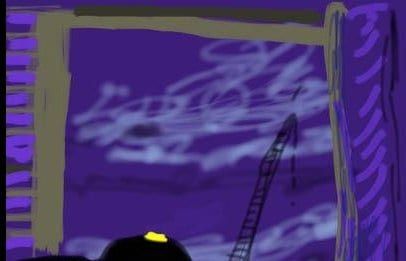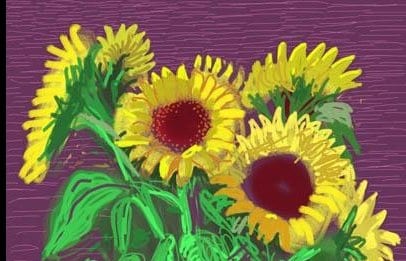
Untitled, 28 May 2010 No 3, iPad drawing. Credit: xtra files
David Hockney holds court in a suite at the Park Hyatt hotel in Toronto. There is a spark of mischief when he speaks, along with the occasional curse word and sprinkling of laughter. “I am still not a respectable person,” he says proudly. With a dapper blazer, a thin blue-and-white tie and a cigarette in hand, there is nothing particularly grandfatherly about the 74-year-old artist.
Born in England in 1937, the fourth of five children, Hockney is one of the leading artists of his generation. He has created a vast body of work in a multitude of media – canvas, collage, photography, set design and now the iPad – that has become a pop culture hallmark. Copies of his paintings regularly adorn dormitory walls and poster shops.
Hockney didn’t so much come out of the closet as he ricocheted from it. “I always knew,” he says with a hearty laugh. “When I was 22 . . . I just came out because someone said, ‘Well, I saw you at a pub with somebody,’ and they started going on, and I said, ‘Too bad for you then,’ and I just thought, ‘Well, fuck off, actually.’”
Though England and Wales did not decriminalize gay sex until 1967, Hockney says he never felt marginalized because of his sexual orientation.
“I lived in a bohemia then,” he says. “The whole art world was a bohemia until the money took over, and you lived it. For instance, Quentin Crisp was a model at the London College of Arts when I was there as a student. He was one of the first obviously gay people who touted himself as such . . . But that was the art school atmosphere; you felt very free. The other world, the suburban world, was what you left behind.”
When I mention the notion of a gay aesthetic, Hockney responds with a personal anecdote. “A friend of mine – this is 30 or 40 years ago – we were looking at pictures of a girl’s legs, and he said to me, ‘You know David, if there is one thing worse than homosexual art, it’s heterosexual art,’ meaning there is only art. But a gay aesthetic? I don’t know. There could be . . . but I am not sure . . . There’s art, just art, really.”
Homoerotic themes seem unavoidable in art history: Guido Reni, Michelangelo, Francis Bacon, Robert Mapplethorpe and Hockney himself. But Hockney disputes this. “When people go on about Caravaggio’s homosexuality, I would point out that they wouldn’t have viewed us like that then. First of all, he probably fucked anything that came along . . . Homosexuality is kind of a modern invention in that way, I should think.”
Hockney’s latest exhibition, Fresh Flowers, has garnered mixed reviews from critics who bemoan a lack of subtext in the 200 works on display at the Royal Ontario Museum’s Institute of Contemporary Culture. The work has been deemed nothing more than pretty or, worse, pedantic imagery of gardens and flowers that isn’t really art. “Do they know what art is?” replies Hockney. “It’s not so easy to define what art is, is it?”
Though these iPad creations lack the homoeroticism and grandeur of Hockney’s earlier work, there is something about them reminiscent of late-period Matisse construction-paper cutouts. Those works have weathered the test of time to become an enduring part of art history and Matisse’s legacy. Like them, there is something brave and compelling in Hockney’s very modern computer-generated works. Perhaps they will be Hockney’s construction-paper cutouts.

 Why you can trust Xtra
Why you can trust Xtra


